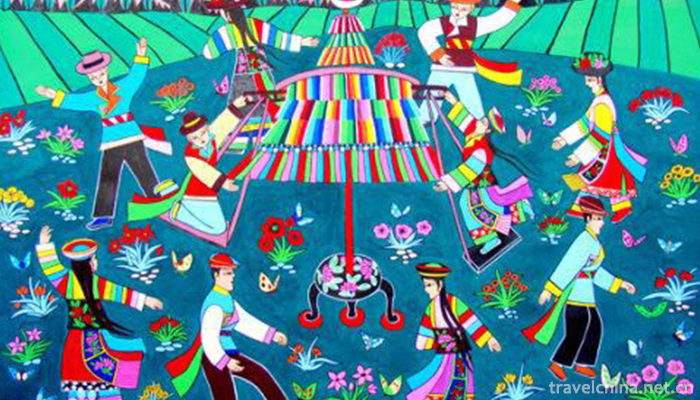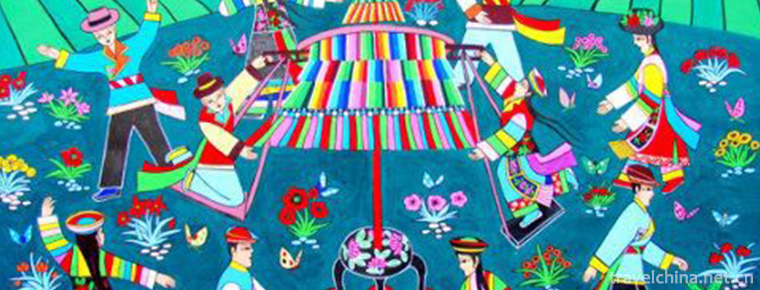Turkish Pan Embroidery
Turkish Pan Embroidery
Tu Pan Embroidery, a traditional Tu folk art in Huzhu County, Qinghai Province, is one of the national intangible cultural heritages.
Pan embroidery is the most important embroidery method in Chinese Tu embroidery, and it is a compulsory course for Tu women in their lifetime. Pan embroidery is a unique embroidery method of the Tu nationality, which is complex and ingenious and contains the profound connotation of the ancient Tu culture. In the eastern mountainous area of Qinghai Plateau, industrious and simple Tu women have inherited the ancient traditional national embroidery art from generation to generation. Their embroidery skills are exquisite, their workmanship is exquisite and skillful.
On May 20, 2006, the Turkish pan embroidery was approved by the State Council and listed in the first batch of national intangible cultural heritage list.
Historical Origin
In the Tuguhun tomb excavated in Dulan County, Qinghai Province, embroidery similar to pan embroidery was unearthed, from which we can see that Pan embroidery technology has appeared around the 4th century.
Li Faxiu, the representative inheritor of Tu pan embroidery, made innovations from various perspectives: in pattern design, incorporating the elements of the times and symbolic events, bringing fresh flavor to Tu pan embroidery; in category development, practical types such as sachets, purses and pendants are the main types, while the base material of Pan embroidery is changed from traditional black cotton cloth to brocade, making it more beautiful.
Cultural characteristics
Artistic Characteristics
Pan embroidery is silk embroidery, with red, yellow, green, blue, cinnamon, purple, white and other seven-color embroidery, embroidery is generally full of seven colors, color coordination, bright and dazzling. The design of Pan embroidery is ingenious and has a strong national style, including dozens of styles, such as Falun, Taijitu, Five-petal Plum, Immortal Queen, Moire, Rhombus, Sparrow Head, Fortune Head, Character, Buddha Statue, etc. The embroidery stitches of Tu nationality are delicate and distinct.
Production process
Disc embroidery material is exquisite, fine processing, with black cotton cloth as the base material, and then choose the fabric paste. The needle method of disc embroidery is very unique. When the needle is manipulated, two threads of the same color are used, one for disc thread and the other for sewing. Disk embroidery does not need a scaffold, but operates directly with both hands. The embroiderer holds the cloth in his left hand and the needle in his right hand. The thread for the diskette thread hangs on his right chest, and the thread for the suture thread goes through the eye of the needle. Upper needle tray, lower needle sewing, one needle and two threads, although labor and materials, but the finished product is thick and gorgeous, durable.
Subject works
Pan embroidery can be seen everywhere in Tu people's life. It involves headdress, collar, belt, pillow towel, needle tie and purse. The most common patterns are Babao, Caiyun, Taijitu, rich head, eight lotus petals and so on. The main works are Tu flower sleeve shirts (called "Xiusu" in Tu language)
Inheritance and Protection
Inheritance value
The Tu embroidery with a thousand-year history has been handed down till now, and its cultural and artistic value can not be underestimated. Turkish pan embroidery is colorful and lifelike in design. It reflects the aesthetic attitude and value judgment of the nation in shape, color, quality and meaning. It provides fresh materials for the study of Ethnology and aesthetics.
Turkish pan embroidery works show the extensive and exquisite folk culture and art of the Turkish people, and have high ornamental and collection value.
The Tu pan embroidery art is an important carrier of the Tu culture and a cultural product with distinct ethnic regional characteristics. It carries too much cultural information in the history of national change and is the material symbol of the spiritual cohesion of the whole Tu nationality.
Heritage figures
Li Faxiu, female, Tu nationality, born in 1959, is a native of Huzhu Tu Autonomous County, Qinghai Province. The first batch of national intangible cultural heritage projects are representative inheritors of Tu embroidery.
protective measures
Under the guidance of Qinghai University for Nationalities, Huzhu Tu Autonomous County of Qinghai Province set up three cooperatives of township enterprises for Tu embroidery, which helped sign an order of 90,000 yuan for Suzhou famous brand enterprises, benefiting more than 300 local Tu embroidery mothers.
Relying on Colleges and universities in and outside Qinghai Province, Qinghai has held 16 training courses for inheritors of national and provincial non-heritage projects, such as Tangka, Japanese stone carvings, Huangzhong silver and bronze wares, Huangzhong embroidery, Tu pan embroidery, Hehuang embroidery, Gologesar handicraft and so on, with a cumulative training of more than 900 people.
social influence
Important activities
During the 2008 Beijing Olympic Games, Li Faxiu participated in the exhibition of folk art "Chinese Stories" recommended by Qinghai Cultural Department. Since then, the "non-surviving flower" inheriting the emotions between Tu women and mothers has won many honors such as the Gold Prize of China Weaving and Embroidery Exhibition, and performed at the UN Women's Congress.
The Turkish pan embroidery works won the gold medal in the 2009 "Splendid China" China Weaving and Embroidery Exhibition.
In 2013, Tu embroidery participated in the 4th Chengdu International Intangible Cultural Heritage Festival of China, co-sponsored by the Ministry of Culture, the Sichuan Provincial Government, the National Committee of UNESCO of China and UNESCO.
On December 11, 2017, the intangible cultural heritage exhibition of the Marine Silk Road opened in Quanzhou, Fujian Province, the starting city of the ancient Marine Silk Road. On-site exhibitions of the splendid "non-relics" treasures on the "Haisi" road included the Tujia embroidery in Qinghai, the traditional embroidery techniques in Beijing, the Yangliu Youth Painting in Tianjin, and the Manchu paper-tearing skills in Changbaishan, Jilin Province. The style highlights the master craftsman's superb craftsmanship and ingenuity, conveying a strong regional characteristics and national customs.


-
1.Ancient Villages in Southern AnhuiXidi and Hongcun
Ancient villages in southern Anhui refer to some traditional villages distributed in Anhui and Jiangxi provinces of China and south of the Yangtze River.
Time 2018-12-08 -
2.Shanghai Museum
The Shanghai Museum was founded in 1952. It was originally located at the Old Jockey Club at 325 Nanjing West Road. It moved to the Zhonghui Building at 16 Henan South Road in October 1959
Time 2018-12-19 -
3.Great Wall of Ming Dynasty in Datong County
According to documents, the Great Wall of Qinghai Province in the Ming Dynasty was built in the middle of the Ming Dynasty. It lasted 51 years from 1546 to 1596.
Time 2019-01-07 -
4.Guangyou Temple Scenic Area
Guangyou Temple is located in Liaoyang City, Liaoning Province, with Baita in the West and moat in the east. It covers an area of 60,000 square meters. The central axis of the north and south is archw
Time 2019-01-13 -
5.Zhujiajiao Ancient Town
Zhujiajiao Town, which belongs to Qingpu District of Shanghai, is located in the West and south of Qingpu District, close to Dianshan Lake Scenic Area. It is bounded by Daying in the East and Huanchen
Time 2019-03-20 -
6.Block door La shou men
Stopper Gate is one of the traditional Chinese boxing schools. It originated in Shaolin and was introduced to Tianjin in the early Qing Dynasty. It originated in Sichuan. It was the earliest southern
Time 2019-05-10 -
7.Green Tea Production Techniques
Green tea production technology is a national intangible cultural heritage. Luan Guapian is a special kind of green tea. Cucumber seed-like flake-shaped tea is made from local endemic varieties by wre
Time 2019-05-15 -
8.Manas
Manas, the traditional folk literature of Kirgiz Autonomous Prefecture in Kizlesu, Xinjiang, is one of the national intangible cultural heritage.
Time 2019-05-16 -
9.Brow tune
Meihu Opera is a local traditional drama in Shaanxi Province. From the development of the floor stall rap and social fire, the floor stall and social fire performances always focus on singing. Its act
Time 2019-06-01 -
10.Yi dress
The costumes of the Yi nationality are colorful, unique in style, and have nearly 100 kinds of shapes. Historically, because of the numerous branches and scattered residence of the Yi people, there ar
Time 2019-07-12 -
11.Zhang Jia Agui
Ah Kui (September 7, 1717 - October 10, 1797). Zhang Jiashi , word Guang Ting , Number Cloud cliffs Manchuria's blue flag people (after the war in Xinjiang were promoted to Zheng Bai Qi), a Bachelor o
Time 2019-09-11 -
12.Anhui Science And Technology University
Anhui Science and Technology University is located Anhui Province Chuzhou City Fengyang County and Bengbu City By the state Ministry of Education Approved full-time full-time undergraduate universitie
Time 2019-10-10